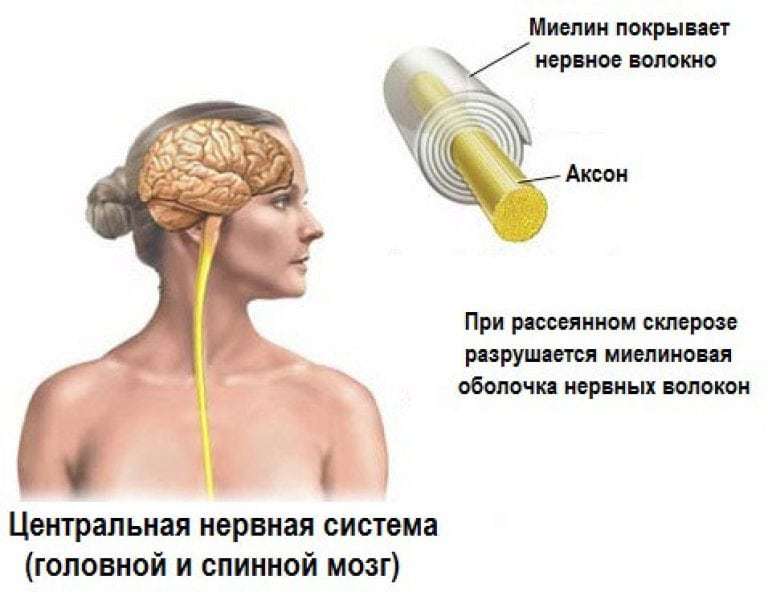Multiple sclerosis: symptoms in women, causes
Multiple sclerosis is a chronic and progressive damage to the central nervous system, in other words, chronic autoimmune disease, during which the ability to perform independent actions is lost.
The disease is not associated with the well-known senile sclerosis and carries its name from the features.
Content
- What is multiple sclerosis?
- How does the disease manifest itself
- Some historical facts
- Research
- Disease statistics
- Multiple sclerosis symptoms
- Causes of the onset of the disease
- Sclerosis classification:
- Diagnostics and treatment
- Prophylaxis
- Related Videos
What is multiple sclerosis?
Multiple sclerosis is so called because foci of the disease are present throughout the human body. It bears the name "sclerosis", as it describes the nature of the disease - plaques in the human brain.
A similar ailment like multiple sclerosis is about 35 years old.
It is generally accepted that the disease is an autoimmune disease due to which the human immune system suppresses its own organs. During this process, the body destroys myelin - a special layer that covers and warns the nerve endings of the spinal cord and brain.
In simple terms, myelin can be compared to insulation on wires. Scars form at the site of damage. If the myelin sheath is damaged, then the message of impulses passing through the nerves slows down, which is reflected in one or another organ of the patient. The damaged nerve tissue is replaced by connective tissue.
How does the disease manifest itself
It is manifested by visual disturbances, pathology of the motor, sensitive, coordinating spheres. Often people with multiple sclerosis begin to experience relapses of symptoms, which may be accompanied by moments of partial or complete remission.
Some historical facts
The problem was first described in 1830 by the French pathologist J. Cruvelier in the atlas of pathological anatomy. Subsequently, the clinical and pathological picture of this disease was highlighted. However, knowledge about it has not been enriched enough to consider the problem solved.
The more specialists studied multiple sclerosis, the greater the distance between the views of theorists and practitioners on the cause, the mechanism of the development of the disease and the treatment of patients.
Scientists have suggested that the causative agent of multiple sclerosis may be some spirochetes and viruses that cause inflammation.
In 1910-1936, a number of studies were carried out to identify the causative agent of the disease. However, it was not possible to reproduce MS symptoms in animals by transferring the “pathogen” from a sick person.
There is still a concept about the viral origin of multiple sclerosis. Opponents of the infectious theory of the onset of the disease believed that it was caused by internal factors.
The impetus in the knowledge of the causes and mechanisms of the development of the disease was the event when scientists first succeeded in monkeys, and then in guinea pigs, as well as rats, cause an experimental allergic encephalomyelitis.
Numerous scientific facts obtained by the reproduction of experimental allergic encephalomyelitis gave rise to a theory of the neuroallergic origin of the disease.
Read also:Cerebral palsy (cerebral palsy)

Despite the significant advances in modern medical science in the study of demyelinating processes, the causes and mechanisms of MS development have not been fully elucidated.
There is a general consensus that infectious, genetic and geographical factors influence the onset of the disease. Some scientists consider multiple sclerosis to be an infectious disease that is caused by a virus. This statement is confirmed by high titers of antibodies in the blood and cerebrospinal fluid of patients.
High titers of antibodies prompted researchers to believe that persistent viruses determine the disease. There are reports in the literature that the persistence of viruses implicated in the onset of multiple sclerosis is associated with DNA. DNA stores and transforms genetic information in nerve cells.
Research
At the present time, more and more researchers are inclined to the theory of the onset of the disease as a genetically determined pathology. A genetic predisposition to multiple sclerosis is evidenced by the fact that the disease more often affects children whose parents are related by family ties. At the same time, the problem is almost not observed in three generations.
The results of epidemiological studies have shown that the disease is more often found in the northern hemisphere of the Earth, the same trend continues in the direction from east to west. That is, the so-called geographical factor was established.
There are opinions of scientists about the alimentary (food) factor in the occurrence of multiple sclerosis. The consumption of large amounts of animal fats and carbohydrates, an insufficient amount of proteins and amino acids cause hypovitaminosis, as a result of which the metabolism in the body is disrupted. Without diminishing the role of any theory of the development of the disease, the infectious-allergic one remains the leading one.
Its essence lies in the fact that the cause of the disease is an infectious factor with neurotropic properties.
Disease statistics
To begin with, multiple sclerosis affects mainly people of working age - from fifteen to forty years. After the turn of fifty, the risk of getting sick decreases sharply. It also happened that even children got sick with multiple sclerosis.
The likelihood of this diagnosis depends not only on age, but also on gender. Women get sick more often than men almost three times, however, they tolerate it more easily.
Race also influences the risk of getting multiple sclerosis. East Asians are the least affected. But European doctors make such a diagnosis quite often. Due to the lack of vitamin D, inhabitants of the northern regions of the planet have a greater risk of suffering from this disease.
Multiple sclerosis symptoms

There are many signs of this disease. Symptoms may disappear and change for others.
At the beginning of the development of the disease, there are not so many symptoms, and they include:
- Feeling of numbness and painful tingling in your fingers;
- Bilateral or unilateral visual impairment;
- Muscle weakness;
- Coordination problems;
- Eye pain double vision.
Read also:What is autism in simple words, how it manifests itself in children, signs, photos
In the next stages, when the number of so-called sclerotic plaques increases, the symptoms become more:
- Incomplete paralysis of the legs and arms;
- Difficulty of movement;
- Problems with urination, bowel movement (inability to control these processes is possible);
- Spasms, muscle pain;
- Increased fatigue;
- Conduct disorder;
- Essential tremor;
- Decreased intelligence;
- Cranial nerve palsy;
- Oscillatory movements of the eyeballs;
- Coordination problems;
- Problems in the area of the optic nerves;
- Decreased sensitivity of the skin;
- Dysfunction of the ureter;
- Balance problems;
- Cognitive impairment;
- Changes in the patient's mood;
- Heaviness in the leg area;
- Increased feeling of weakness;
- Fatigue at rest.
Psychoemotional signs include emotional instability, changeable mood - the alternation of a depressive state with euphoria. Neuroses are also possible.
Causes of the onset of the disease

The main reason for this diagnosis is considered to be a failure in the immune system, when lymphocytes entering the brain, instead of attacking harmful bacteria, begin to attack their own cells.
The myelin sheath of nerve cells is destroyed by antibodies produced by lymphocytes.
At the site of these destruction, inflammation is formed, then - scar tissue, plaques. Therefore, then the brain is unable to ensure the normal functioning of the movements.
The following factors can provoke multiple sclerosis:
- missing vitamin D;
- genetic predisposition;
- constant severe stress;
- bacterial infections as well as viral.
The consequences can be different. Young patients are more likely to have a benign course of the disease than adults. About a quarter of cases ends quite favorably, and the patient remains independent.
Through laboratory studies, specialists have revealed that a number of factors contribute to the occurrence of this chronic autoimmune disease. Researchers have divided them into modified and uncontrolled.
Uncontrollable factors:
- genetic factors. They arise as a result of inheritance from parents or relatives.
- ethnicity is also an uncontrollable factor.
- age factor. It has been established that sclerotic changes occur mainly in women during menopause, and in men when they reach forty-five years.
Modified factors:
- high blood cholesterol;
- hypodynamia;
- the patient's lifestyle;
- bad habits (smoking, alcoholism);
- disruptions in the mechanism of blood coagulation;
- high blood pressure.
It is known that the disease, at a certain stage, destroys the nervous system. Therefore, a number of disease classifications have been created. Thanks to which it becomes possible to determine the period and stage of the disease. The classification is very important for the further treatment of the patient.
Sclerosis classification:

Classification is possible only when establishing how much the system of nerve cells is damaged, and which organs have suffered as a result of the disease.
- Multiple sclerosis. Disease of the autoimmune system, violation of the blood cells of the nervous system.
There are clinical forms of multiple sclerosis:
- Cerebrospinal;
- Optical;
- Spinal;
- Cerebellar.
It is important to note that the problem arises due to the depression of the nervous system. To determine multiple sclerosis, the symptoms of the disease were identified.
Complications are an important aspect in the study of multiple sclerosis.
There are two types of complications: malignant type and benign type.
- In the case of a malignant type, as a rule, treatment does not help. The lethal outcome occurs several months after the onset of the active phase of the disease.
- The benign form of multiple sclerosis is treatable, but in most cases it leads to disability. In case of deterioration of the condition, it is not diagnosed for about fifteen years, there is a rare and frequent destruction of motor functions, loss of control over them by the body.
- Arteriosclerosis is a chronic type. In the process of the appearance of hardened cholesterol spots, a violation of the blood supply occurs. Usually, this failure leads to heart ischemia.
- Sclerosis of vascular cells in the predominant brain - Due to the death of brain cells caused by impaired blood circulation, there is a lack of nutrients. Cysts are formed instead of brain cells.
- Nephrosclerosis - is formed on the basis of destruction or damage to the blood flow to the kidneys. As a result, normal tissue is replaced with scar tissue.
- Cardiosclerosis - contractions in the area of the heart muscle slows down noticeably, as a result of the appearance of scar tissue in the heart valves.
- Amyotrophic lateral sclerosis - the death of neurons in the brain, leading to muscle atrophy and the formation of paralysis.
Read also:Benign paroxysmal positional vertigo (BPPV)
Diagnostics and treatment

Walking to different specialists will still lead to a neurologist who suspects a possible disease.
It is possible to accurately determine the signs of this ailment using MRI.
The MRI scan shows the presence of foci of demyelination, which indicates the disease.
Diagnostics, as a rule, includes several main stages:
- Patient interview;
- Neurological examination;
- Therapeutic examination;
- Blood test;
- Analysis of immunoglobulins.
Magnetic resonance imaging procedures are mandatory. To confirm an accurate diagnosis, it is very important to go through all the procedures and tests prescribed by the doctor.
However, the doctor may prescribe additional tests and procedures if the standard, mandatory diagnostic methods do not show an accurate result.
The patient's treatment depends directly on the indications of the attending physician. Treatment can include prescribed drugs and procedures that must be followed.
Prophylaxis
To avoid exacerbations of the disease, doctors recommend that patients normalize their weight, start going in for sports (while you cannot exhaust yourself), try not to experience severe stress, mental fatigue, and also give up bad habits such as smoking or frequent use alcohol.
Overheating and taking hormonal contraceptives are unacceptable for the patient.
Even when symptoms are alleviated, the patient should continue to take the medication prescribed by the doctor.
Thus, multiple sclerosis develops in each person in its own way, and in any case, one cannot lose hope that the disease will proceed benignly.


